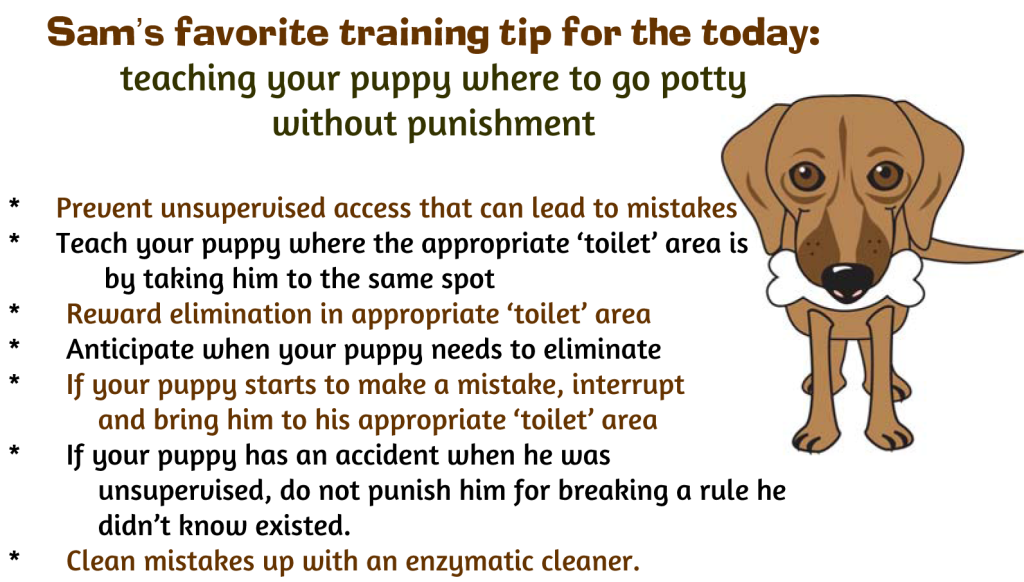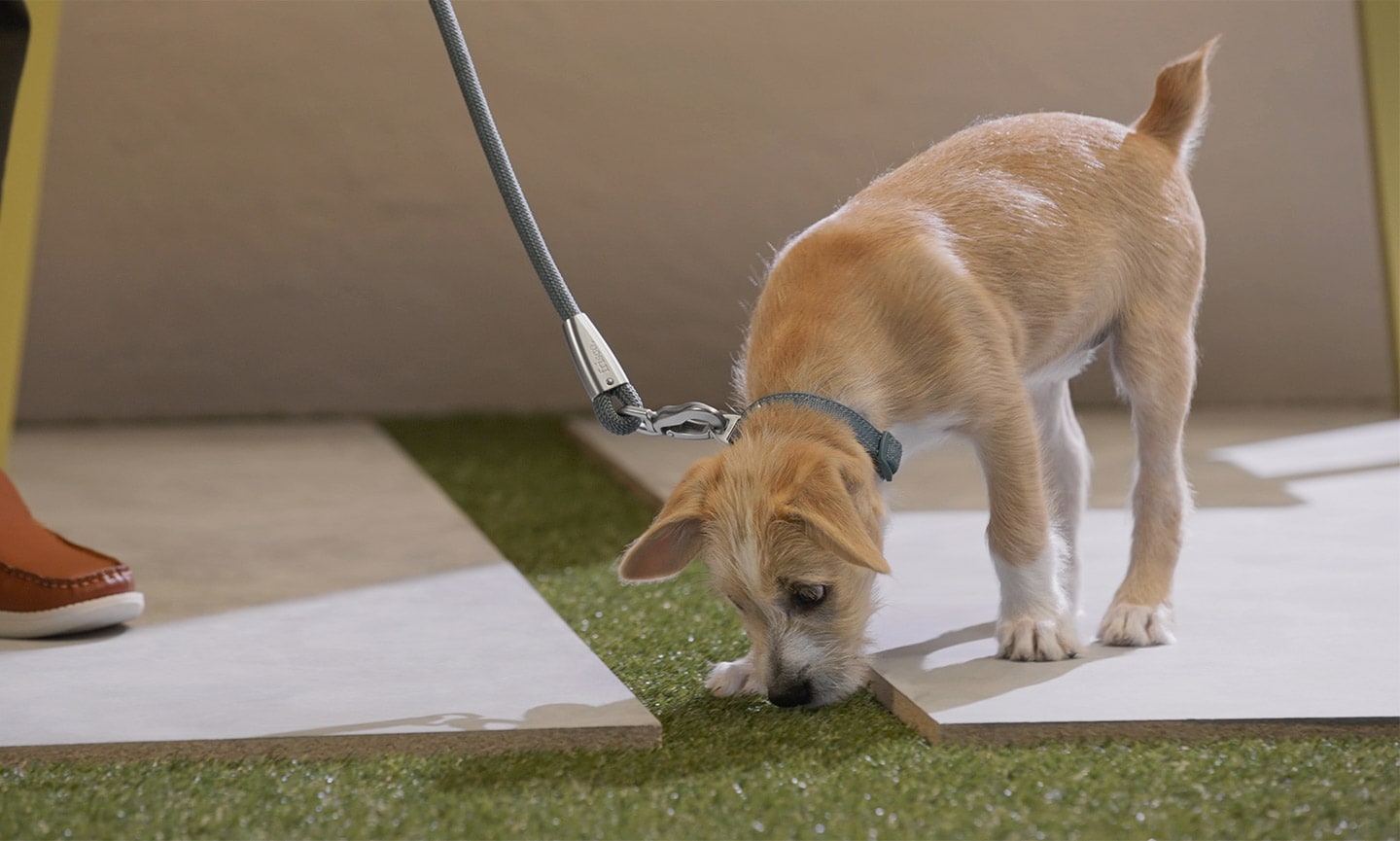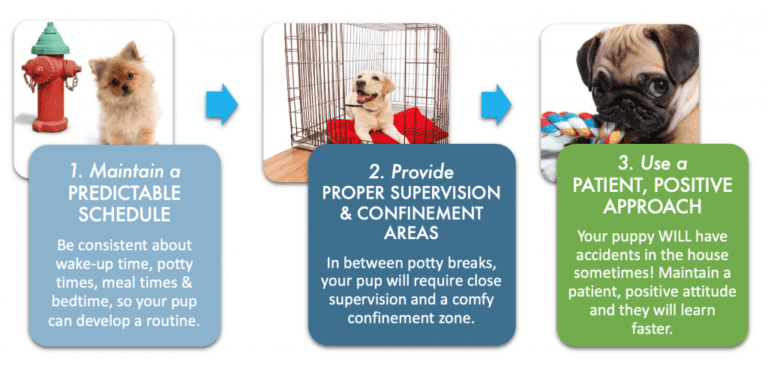To housetrain your puppy, consistency and patience are crucial. With character, you can expect to complete house training within four to six months.
Most puppies will acclimate to house training within a few weeks.

Methods For Puppy House Training
Potty training your new puppy ensures a happy and healthy environment for you and your furry friend. You can quickly teach your puppy to eliminate in the appropriate areas by using effective methods and approaches. In this section, we will explore three critical strategies for puppy house training: avoiding puppy pee pads, using puppy crate training, and providing proper supervision.
Avoid Puppy Pee Pads
While puppy pee pads seem convenient for house training, they can hinder the process. Pee pads teach your puppy that it is acceptable to relieve themselves indoors, making the transition to outside elimination more challenging. Instead, prioritize taking your puppy outside on a regular schedule. This consistency will help them understand the desired behavior and reinforce the idea that going outdoors is the appropriate place to potty.
Puppy Crate Training
Crate training is an effective method for house training as it utilizes your puppy’s instincts to keep their sleeping area clean. When properly sized, a crate becomes your puppy’s safe and comfortable den-like space. They will instinctively avoid soiling this area, encouraging them to hold their bladders until they are let outside. Gradually introduce your puppy to the crate, making it a positive experience with treats and toys. Remember to choose a crate size that allows your puppy to stand up, turn around, and lie comfortably.
Puppy House Training Supervision
Supervision is crucial during the house training process. By closely monitoring your puppy, you can anticipate when they need to be eliminated and promptly take them to the designated potty area. Keep your puppy within sight to prevent accidents and provide immediate feedback when they display appropriate elimination behavior. Consistency is vital, so take them outside frequently, especially after meals, playtime, and nap time. Avoid distractions during this time, allowing your puppy to focus on their potty training.
Implementing these methods for puppy house training will set you and your furry companion up for success. Remember to be patient consistent, and provide positive reinforcement for desired behavior. With time and proper training, your puppy will quickly learn where and when to eliminate, leading to a clean and well-trained household.
Tips And Techniques
House training your puppy can be challenging, but with the right tips and techniques, you can make the process easier and more effective. This section will discuss key strategies to help you successfully housetrain your furry friend.
Why Use Crate For Puppy House Training
A crate is one of the most effective tools for house training your puppy. A container provides your puppy with a safe and secure space and can help with potty training. When properly used, a box can teach your puppy to hold their bladder and only eliminate it when outside. It also helps establish a consistent routine and prevents accidents in the house. When choosing a crate, ensure it is large enough for your puppy to stand, turn around, and lie comfortably.
The Importance Of Location
Choosing the right location for your puppy to do their business is crucial. Designate a specific spot in your yard that is easily accessible and clean. Take your puppy to this spot consistently to reinforce the habit of eliminating outside. The scent left behind will also serve as a marker for your puppy, making it easier for them to recognize the designated area as their bathroom. Clean up any accidents inside the house thoroughly to prevent your puppy from thinking it’s an acceptable place to go.
The Best Way To Take Your Puppy Outside
When taking your puppy outside, it’s essential to do it correctly. Use a leash to ensure your puppy stays in the designated potty area and is not distracted. Take them out immediately after waking up, eating, or playing, as these are typical times for puppies to need to be eliminated. A consistent command, such as “go potty” or “do your business,” will also help your puppy associate the action with the order. Be patient and give your puppy plenty of time to sniff and explore before they find the perfect spot.
In conclusion, implementing these tips and techniques will significantly improve the success of house training your puppy. Using a crate, choosing the right location, and taking your puppy outside correctly are all essential steps. Remember to be patient and consistent; soon enough, your puppy will be fully housetrained and happy.
Indoor Potty Training Options
Are you looking for indoor potty training options? Learn how to housetrain your puppy effectively with these helpful tips and techniques. From crate training to proper supervision, your puppy potty will be trained quickly.
When it comes to house training your puppy, various indoor potty training options are available that can make the process easier and more convenient for you and your furry friend. These options provide a designated area for your puppy to relieve themselves indoors while also helping to minimize mess and odor in your home. Here are some indoor potty training options you can consider:
Lomantown Fake Grass Dog Potty
The Lomantown Fake Grass Dog Potty is an excellent option for indoor potty training. It features a realistic grass surface miming the outdoors, making it easier for your puppy to transition to outdoor potty training later. The grass is also easy to clean and maintain, ensuring a hygienic environment for your pup.
Petmaker Puppy Potty Trainer
The PETMAKER Puppy Potty Trainer is another excellent choice for indoor potty training. It comes with a three-layer system that includes a grate, tray, and collection tray to prevent your puppy from stepping on their waste. The removable tray makes clean-up a breeze, saving you time and effort.
Ps Korea Indoor Dog Potty Tray
The PS KOREA Indoor Dog Potty Tray is designed with high-quality materials that are durable and easy to clean. The tray has a non-slip surface to ensure stability, making it ideal for puppies still learning to balance. Its portable design allows you to place it in different areas of your home as needed.
Ottomanson Pet Non-slip Easy Clean
The Ottomanson Pet Non-Slip Easy Clean is a non-slip mat that can be used as a potty area for your puppy. It is made of a soft, absorbent material that locks in moisture and prevents leaks. The non-slip backing keeps the mat in place, providing a secure surface for your puppy.
Weasy Smart Dog Potty Odor Free
The Weasy Smart Dog Potty Odor Free is a high-tech indoor potty training option. It features a sensor-activated system that automatically flushes your puppy’s waste away, meaning you don’t have to clean up after them manually. It also includes an odor control system to keep your home smelling fresh.
Petsafe Pet Loo
The PetSafe Pet Loo is a convenient and portable indoor potty training solution. It consists of a synthetic grass mat that sits on top of a collection tray. The tray holds your puppy’s waste, and the grass mat provides a natural feel for your pup. The Pet Loo is available in various sizes to accommodate different breeds.
Dog Potty Training Spray
You can consider using a dog potty training spray for added assistance in potty training your puppy. These sprays attract your puppy to specific areas or surfaces, making it easier for them to understand where to go. Some popular options include PoochPad Potty Training Attractant, Nature’s Miracle Advanced Stain and Odor Eliminator, Bodhi Dog Potty Training Spray, and NaturVet Potty Here Training Aid Spray.
These indoor potty training options provide flexibility and convenience while helping your puppy learn where to relieve themselves indoors. Remember to be consistent and patient throughout the house training process to ensure successful results.
Easiest And Hardest Breeds For Potty Training
House training a puppy can be a challenging task for any dog owner. However, some dog breeds are known to be easier or more complicated regarding potty training. Understanding these differences is essential to setting appropriate expectations and developing an effective training plan. This article will explore the easiest and hardest breeds to potty train and provide tips and insights for each.
Easiest Dogs To Potty Train
Certain breeds tend to catch on quickly and have an easier time understanding and following the training process when it comes to potty training. Here are some of the easiest species to potty train:
- Miniature Schnauzer: Miniature Schnauzers are intelligent and eager to please, making them quick learners in potty training.
- Labrador Retriever: Labs are known for their trainability and willingness to learn, which also extends to potty training.
- Papillon: Despite their small size, Papillons are highly intelligent and can be easily trained to use a designated potty area.
- Poodle: Poodles are quick learners and have a strong desire to please their owners, which makes them receptive to potty training.
- Yorkshire Terrier: While small, Yorkshire Terriers are intelligent and can be successfully trained to use a designated potty area.
- Maltese dog: Maltese dogs are known for their intelligence and learning ability, making them relatively easy to potty train.
Most Brutal Dogs To Potty Train
On the other hand, certain breeds may require more time and effort when it comes to potty training. These breeds may have a stubborn streak or be less receptive to training. Here are some of the most challenging species to potty train:
- Chihuahua: Chihuahuas can be stubborn and tend to be independent, which can make potty training a challenge.
- Beagle: Beagles have a strong sense of smell and are easily distracted, making it harder to focus during potty training.
- Dachshund: Dachshunds can be stubborn and have a strong instinct to dig, making potty training more difficult.
- Pekingese: Pekingese dogs are known for their independent nature, which can make them less receptive to potty training.
- Bulldog: Bulldogs can be stubborn and have a strong will, making potty training challenging.
- Basset Hound: Basset Hounds are known for their stubbornness and independence, which can make potty training a longer process.
While these breeds may pose a more significant challenge regarding potty training, it is essential to remember that every dog is unique. Any breed can be successfully housetrained with the right approach, patience, and consistency.
Faqs On Puppy House Training
Discover the easiest way to potty train your puppy with our FAQs on Puppy House Training. Learn valuable tips and tricks to housetrain your furry friend in seven days, ensuring a smooth transition to a well-behaved and potty-trained pet.
What’s the Easiest Way to Potty Train a Puppy?
Potty training a puppy can be challenging, but with the right approach, you can make the process easier for you and your furry friend. Consistency and positive reinforcement are the easiest ways to potty train a puppy. Here are a few steps to get you started:
- Establish a routine: Set a regular potty schedule for your puppy. Take them outside to the designated spot at the exact times every day, such as after meals, playtime, and naps.
- Use crate training: When you can’t supervise your puppy, keep them in a crate or a confined area. Dogs are intuitive about cleaning their living space, so they are less likely to eliminate in their box.
- Reward good behavior: Praise and reward your puppy with treats, toys, or verbal praise when they are in the right spot. This positive reinforcement will reinforce the desired behavior and make them more likely to repeat it.
- Be prepared for accidents. Accidents will happen, especially during the early stages of training. When accidents occur, remain calm and clean up the mess promptly using an enzymatic cleaner to eliminate odors that may encourage future accidents.
- Monitor and supervise: Keep a close eye on your puppy when they are indoors. Watch for signs such as sniffing, circling, or restlessness, indicating they may need to go outside.
How Long Does It Take To Potty Train A Puppy?
Consistency and patience are crucial to success when potty training your puppy. While the exact timeline may vary depending on the breed, age, and individual puppy, most puppies will acclimate to house training within a few weeks. However, it’s important to note that complete house training usually takes four to six months. By investing time and effort in consistent exercise, you can help your puppy master this essential skill at their own pace.
At What Age Should A Puppy Be House Trained?
The age at which a puppy can be effectively housetrained may vary, but most puppies can start the process as early as 12 weeks. However, it’s essential to remember that young puppies have limited bladder control and may need more frequent potty breaks. As they grow older, their bladder capacity will increase, allowing them to hold their urine longer. Remember to be patient and consistent with your training efforts, adjusting the frequency of potty breaks as your puppy matures.

Additional Resources
Are you looking for additional resources on how to housetrain your puppy? Check McCann Dog Training and Upstate Canine Academy on YouTube for expert tips and techniques. You can also find indoor potty training options and products on Lomantown and PetSafe.
Pet Products http://www.khpet.com › pet-talk › long-potty-train-puppy
Potty Training a Puppy: How to House Train Puppies, American Kennel Club https://www.akc.org › exp… › training › potty-training-your-puppy
Tips on potty training your dog or puppy—The Humane Society of the United States https://www.humanesociety.org › reso… › tips-potty-training-your-pu…
When it comes to housetraining your new puppy, having all the information you need to ensure success is essential. In addition to the guidance provided in this article, numerous reputable resources are available to assist you throughout the training process. Here are some valuable resources that can help you strengthen your knowledge and master the art of house training:
How To Toilet Train Your Puppy Or Dog (Rspca)
The RSPCA (Royal Society for the Prevention of Cruelty to Animals) provides valuable information on toilet training for your puppy or dog. Their comprehensive guide outlines step-by-step instructions on how to teach your furry friend to eliminate outside. You can successfully train your puppy to become a well-behaved household member with proper consistency and patience.
How Long Does It Take To House Train A Puppy? K&H Pet Products
K&H Pet Products is a trusted source for information on housetraining puppies. Their article breaks down the time frame required for successful house training, emphasizing the importance of consistency and patience. Following their expert advice, you can expect to acclimate your puppy to the housetraining process within four to six months, with most puppies becoming housetrained in just a few weeks.
Potty Training A Puppy: How To House Train Puppies, American Kennel Club
The American Kennel Club (AKC) offers a comprehensive guide to potty training puppies. Their article provides step-by-step instructions and helpful tips to ensure successful house training. Following their expert advice, you can create a consistent routine and establish good habits for your furry companion.
Tips On How To Potty Train Your Dog Or Puppy: The Humane Society Of The United States
The Humane Society of the United States (HSUS) provides helpful tips on potty training your dog or puppy. Their article emphasizes positive reinforcement and rewards as effective training methods. Following their advice can create a positive and successful potty training experience for your beloved furry friend.
Utilizing these additional resources can enhance your understanding of house training and improve your chances of success. Remember, consistency, patience, and positive reinforcement are critical factors in successfully housetraining your puppy. Take advantage of these valuable resources to ensure a smooth and efficient training process!

Frequently Asked Questions On How To Housetrain Your Puppy
What’s The Easiest Way To Potty Train A Puppy?
Consistency and patience are crucial for successful potty training. Take the time to train your puppy and expect results within four to six months. Please set up a crate in your bedroom to help your puppy acclimate to their new sleeping environment.
Avoid using pee pads, and take your puppy outside frequently.
How Long Does It Take To Potty Train A Puppy?
Consistency and patience are crucial to potty training success. Most puppies can acclimate to house training within a few weeks, but training usually takes four to six months.
At What Age Should A Puppy Be House Trained?
Puppies should be housetrained between four and six months old with consistent training and patience. Most puppies adapt to house training within a few weeks.
Where Should A Puppy Sleep First Night?
For the first night, a puppy should sleep in a crate in your bedroom. This way, they’ll know you’re nearby, and you can respond to their needs. Please don’t close the box until they’re comfortable.
Conclusion
House training your puppy may seem daunting, but with consistency and patience, you can succeed. It may take some time for your puppy to acclimate to the training process, but most puppies will start grasping the concept within a few weeks.
Remember to provide regular trips outside, carefully control their diet and schedule, and assess their bladder and bowel control. By following these steps, you’ll be on your way to a well-trained and housebroken puppy. Happy training!

